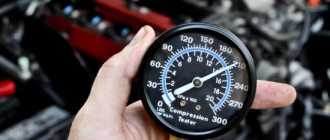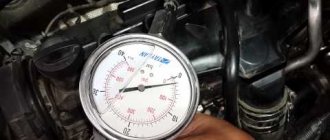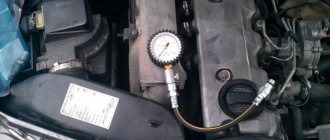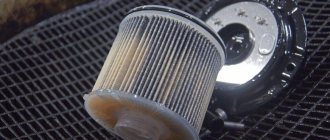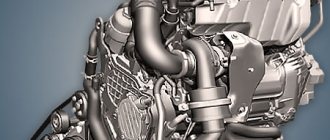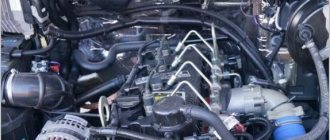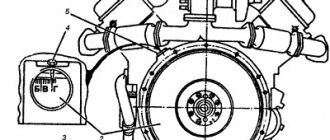Procedure for checking compression
1. Disconnect the connectors of the fuel cutoff valves of the high pressure pump.
2. Turn off the high pressure pump doser.
3. Remove one of the glow plugs.
4. Connect a compression gauge or compressograph to the glow plug flange.
5. Perform a compression test with the starter on. The measurement is considered complete when the compression gauge readings stop increasing.
6. Repeat the measurement, installing the device in place of the next candle. Record the results of each test.
7. Reinstall the spark plugs.
8. Connect the connectors of the fuel shutoff valves and turn on the high pressure pump metering unit.
What do you mean by compression?
One of the main characteristics of the engine, given in the car’s operating instructions, is the compression ratio. This is a dimensionless coefficient showing how many times the air-fuel mixture is compressed before ignition. It is calculated as follows: the volume of one cylinder (including the combustion chamber) is divided by the piston stroke. This parameter is constant and changes only with deep tuning of the engine - boring the cylinders, installing a different crankshaft, and so on.
Uninformed car enthusiasts confuse the compression ratio with compression - the real pressure created by the pistons when the crankshaft is rotated by the starter (200-300 rpm). The characteristic changes as parts wear and is measured in the following units:
- Atm (atmosphere);
- kgf/cm 2 (kilogram-force per centimeter) = 0.97 Atm;
- MPa (megapascal) = 9.9 Atm;
- Bar = 0.99 Atm.
To identify a malfunction of the main engine elements, you need to measure the compression in all cylinders and compare the obtained values with the optimal value. Why does compression decrease during engine operation:
- The working surfaces of the rings, pistons and cylinders wear out, and the gap between them increases. When the crankshaft is turned by the starter, the piston does not have time to “pump up” the pressure in the combustion chamber - part of the air escapes through the cracks into the crankcase.
- The valve plates gradually burn out, do not fit tightly into the seat and allow gases to pass through.
- A “stuck” valve or a completely burnt-out piston does not allow pressure to be created in the cylinder.
- Scratches and scuffs on the cylinders also lead to gas leaks.
These processes occur similarly during engine operation: the fuel does not burn out, gases penetrate into the crankcase, and oil into the combustion chamber. That is, the compression value reflects the real picture inside the engine.
Check conditions
The nominal compression value and the maximum tolerance value can be found in the operating documentation for the vehicle.
The compression check should be carried out at a crankshaft speed of 200-250 rpm. Also a necessary condition for the accuracy of the measured readings is the condition of the air filters. If the filter is clogged, the compression readings may be distorted.
Compression measurements are carried out in the temperature conditions in which the actual engine start usually occurs. There is a direct relationship between ambient temperature and the minimum compression at which the engine can start. This characteristic for a specific engine can be obtained as a result of a series of tests carried out in a service station.
Measuring engine compression is the simplest and most commonly used way to assess the condition and wear of the engine (assessing the condition of the rings, liner wear and valve tightness). A compression test (measuring the compression pressure in a cylinder) is needed to find out the “real” compression in the engine cylinders and compare it with the nominal ones. and also to detect a “sick” cylinder. Thus, measuring compression allows you to identify a malfunction in the cylinder, then diagnostics are continued using specialized diagnostic equipment.
To measure engine compression, a diagnostic device is used - a compression meter . There are even more expensive devices - compressors. This is the same compression meter, only with the ability to graphically record parameters for measuring compression by cylinder.
On many gasoline cars, you can measure the compression yourself, if you want to unscrew the spark plugs, the main thing here is to ensure easy access to the spark plugs. For this purpose, it is enough to buy a simple compression tester for 500-800 rubles (it is usually enough for 2-3 engine diagnostics).
Advice: choose a device with a threaded tip, i.e. so that it is screwed into the spark plug hole, and not pressed into it. Then the compression measurements will be more accurate and can be carried out alone. Also check that the compression gauge pressure release valve is located in the head, which is screwed into the spark plug hole, and not under the pressure gauge. This way you will avoid underestimating compression values when measuring.
For owners of diesel cars, it is better to contact a car service center, because... dismantling an injector or glow plug requires special skills and a special tool, and you will also need a compression gauge with a special adapter for attaching it to the injector or spark plug hole. Although the TU-15A diesel compression tester is purchased from us specifically for a personal car, it is convenient for diagnosing it through the holes for the glow plugs.
Why does compression decrease?
A sharp and unexpected drop in compression for no apparent reason can occur after repairing the internal combustion engine, after numerous attempts to start the unit, or as a result of insufficient crankshaft rotation speed with the starter. In the first two cases, there may be no oil film on the cylinder walls, resulting in insufficient compression for starting. The rotation speed depends on the condition of the battery, starter and other elements, as well as on the viscosity of the engine oil. Excessive fuel or coolant entering the engine crankcase can dilute the oil, which will also lead to loss of compression.
We also recommend reading a separate article about the reasons why compression in a diesel engine may noticeably decrease. From this article you will learn about potential malfunctions of the gas distribution mechanism and cylinder-piston group.
Compression may decrease as a result of timing malfunctions (valve burnout, valve stem destruction or damage to the guide bushing, problems with hydraulic compensators, etc.) A drop in diesel engine compression can also be caused by cracks in the cylinder head or deformation of the adjacent surface of the cylinder head to the cylinder block, destruction of the cylinder head gasket, wear of the cylinder bore, malfunction of the compression rings, burnout and/or destruction of the piston. The engine compression rate is also affected by the degree of coking of the engine (deposits on the piston bottom, the occurrence of piston rings as a result of heavy carbon deposits, etc.)
How to check engine compression
Measure compression by observing the following rules: - the engine must be “warm” (60-80 degrees for the oil to have “working” fluidity); — the fuel supply should be turned off. You can, for example, turn off the fuel pump, injectors, or use other methods to prevent large amounts of fuel from entering the cylinders (so that the oil wedge does not erode); - You need to turn out all the spark plugs. Selective removal of spark plugs is unacceptable, as it increases the resistance to rotation and arbitrarily reduces the speed when the engine is cranked by the starter; — the battery must be fully charged and the starter must be in good working order. Sometimes compression measurement is carried out using a charging device. This increases the accuracy of parameter measurement, because Compression measurements in all cylinders occur at the same crankshaft speed.
HOW TO MEASURE COMPRESSION
Compression measurements are carried out both with the throttle valve open and closed (without touching or fully squeezing the gas pedal). Moreover, each method gives its own results and allows you to identify its own defects.
What should be the pressure in the cylinders?
For gasoline engines, the normal compression ratio is 9-11 and 12-13 kg/cm2, respectively; for diesel engines, the norm is 20 or more and 20-32 kg/cm2.
As you can see, the metrics are very different, and therein lies the difference in their workflow. Low ambient temperatures can be a serious problem. Different pressure ratings can provide starting at different temperatures:
- 28 kg/cm2 and below - starting the engine is possible at a temperature not lower than minus 15 degrees.
- 20-30kg/cm2 – temperature down to minus 20 degrees.
- 32 kg/cm2 – minus 20-25 degrees.
- 36 kg/cm2 – up to minus 30 degrees.
It should be noted that such temperature ranges on a diesel engine are only achievable with a fully operational power unit and auxiliary equipment.
When to check measurement parameters
The compression test procedure must follow the correct scenario.
It is necessary to clearly know the diagnosis in order to correctly determine the condition of the machine. For example, if a car doesn’t start well in winter, it means that the compression needs to be measured when starting on a cold engine. Each engine has its own documentation, which indicates the compression ratio, as well as compression - the minimum parameter, optimal and maximum permissible. If the compression does not match these parameters, the car will start and perform much worse. The normal compression level in a modern diesel engine is 20-25 bar. For an old diesel car the figure is 28-32 bar. The new Common Rail system reaches at least 15 bar for optimal performance. Poor compression on a diesel engine can indicate many problems with the car.
Compression standards in gasoline and diesel engines
It is important to remember that compression should not be below normal. Low performance leads to the following negative consequences:
- Increased crankcase gas pressure;
- Accelerated contamination of the combustion chamber, increased toxicity;
- Increased fuel consumption;
- Significant increase in oil consumption.
What is the norm for this characteristic? To determine the standard pressure in the cylinders of various power units, there is the following formula: the compression ratio specified by the manufacturer in the car documentation is multiplied by a coefficient, which for gasoline power units is 1.2-1.3. A figure from 7 to 12 atmospheres is considered normal.
Compression in a diesel engine is much higher, therefore, the normal limits will be different. For a diesel engine, the compression range is from 25 to 33 kg/cm2. The difference between two different cylinders should not exceed three atmospheres. This figure can be increased, albeit temporarily, through the use of various additives. But it is also worth understanding that too low readings indicate that the engine needs repair. Most often, sleeves need to be replaced. Diesel fuel of unacceptable quality significantly increases the wear of these components.
Compression test procedure and tools
Measuring compression on a diesel engine is not much different from a similar measurement on a gasoline system. In particular, compression testing is most often carried out through the glow plug paths. True, the verification procedure is a little more expensive due to the fact that when dismantling the glow plug, it may break off. What compression meters are on the market?
Compression gauges for glow plugs. The most optimal option, data accuracy and tightness.
There are also compression gauges for checking through the injector connector
Diesel engine compression measurement
Measuring the compression of a diesel or gasoline engine as a process is a series of simple operations during which the percentage of air compression by a piston is measured.
Based on the test results, conclusions are drawn about the condition of the piston group, cylinder, gaskets, and head of this block. For measurements, a special device is used - a compression meter or compressograph. The difference between them is only one thing: the first one measures in real time and the results are not saved anywhere, unlike the second option, when the readings are immediately recorded on electronic or paper media, which greatly simplifies the process if the measurements are taken by one person.
Checking the compression of a diesel engine and a gasoline engine is slightly different. Those aspects that are not important when measuring on a gasoline engine greatly affect a diesel engine. This is why problems often arise when checking compression by an inexperienced technician who does not yet know that such aspects exist.
